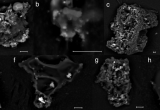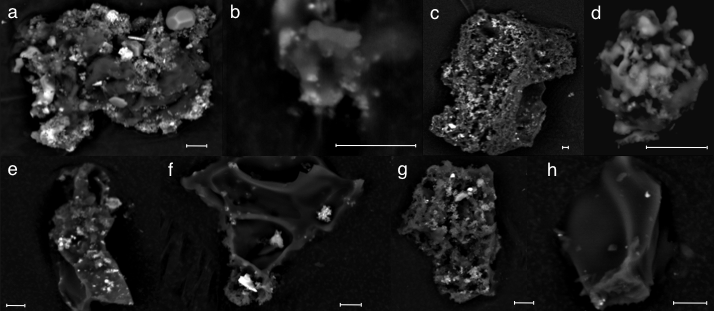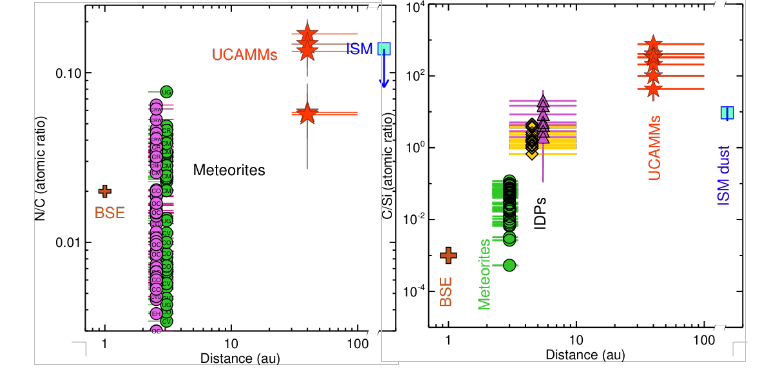Signatures of abundant nitrogen in organic matter from carbon-rich Antarctic micrometeorites
A multidisciplinary team involving researchers from the IAS, CSNSM and SOLEIL SMIS/beam line, has characterized in the laboratory the organic component from exceptional organic-rich interplanetary dust particles, i.e. Ultra-Carbonaceous MicroMeteorites (UCAMMs).
Interplanetary dust particles travel through the solar system and represent the largest mass flux of extraterrestrial material falling on the Earth as micrometeorites, with sizes up to a few hundreds of microns. The UCAMMs characterized in this work were recovered from Antarctic snow in the vicinity of the Concordia Station (*). UCAMMs represent a small fraction of the micrometeorite flux but contain large quantities of organic matter with characteristics differing from other types of extraterrestrial material.
In this work, the authors performed the first systematic survey of eight UCAMMs by means of synchrotron infrared microspectroscopy (μ-FTIR), visible Raman spectroscopy and electron microprobe analyses. The results reveal an organic component with a low aliphatic CH versus aromatic C=C ratio. This UCAMM organic component is nitrogen-rich and oxygen-poor compared to carbonaceous chondrites and IDPs. The μ-FTIR spectra are in agreement with the presence of ketone or aldehyde functional groups and some spectra show both IR and Raman nitrile signature. The spectra are compatible with the presence of C-N bonds in the carbonaceous network, and are significantly different from that reported in organic matter extracted from meteorite. Finally, the silicate-to-carbon ratio in UCAMMs is well below that reported in both IDPs and meteorites.
This comprehensive set of results indicates that the formation of this specific organic compound occurs via physicochemical mechanisms taking place in a cold, nitrogen rich environment, exposed to energetic radiations (photons, cosmic rays), such as the surfaces of icy parent bodies in the outer solar system. Both the C/Si and N/C abundance ratios measured in this work are the highest observed in solar system solids. This peculiar composition of UCAMMs provides an additional hint of the presence of a heliocentric positive gradient in the C/Si and N/C abundance ratios in the solar system protoplanetary disc evolution.
The UCAMMs provides a new insight into the composition of the surface of small icy bodies well well beyond the orbit of Neptune, and can lead to a better understanding of the origin of interplanetary organic matter.
This experimental research is detailed in a recent article published in Astronomy and Astrophysics and highlighted by this journal.
(*) : The Concordia Station is operated by the French and Italian polar institut (IPEV and PNRA).
Contacts : emmanuel.dartois_at_u-psud.fr / cecile.engrand_at_csnsm.in2p3.fr
Associated reference:
« Dome C ultracarbonaceous Antarctic micrometeorites - Infrared and Raman fingerprints » E. Dartois, C. Engrand, J. Duprat, M. Godard, E. Charon, L. Delauche, C. Sandt and F. Borondics, Astronomy & Astrophysics 609, A65 (2018), DOI: https://doi.org/10.1051/0004-6361/201731322
Notes:
This work was funded by the national programmes (PNP, PCMI), the centre national d’études spatiales (CNES), the ANR, the DIM-ACAV, Paris-Saclay University and the CNRS. The micrometeorite collection campaign at the Concordia Antarctic station was financially and logistically supported by the IPEV.
Figure 1: Backscattered electron images recorded at 15kV of fragments of the UCAMMs micrometeorites analysed in the article. Scale bars correspond to 5μm in each image.
Figure 2 : Left, UCAMM (stars) nitrogen abundances relative to carbon (atomic ratio) are compared to solar system solids, in function of heliocentric distance. Right, same for carbon abundances relative to silicon (atomic ratio), compared to solar system solids.






